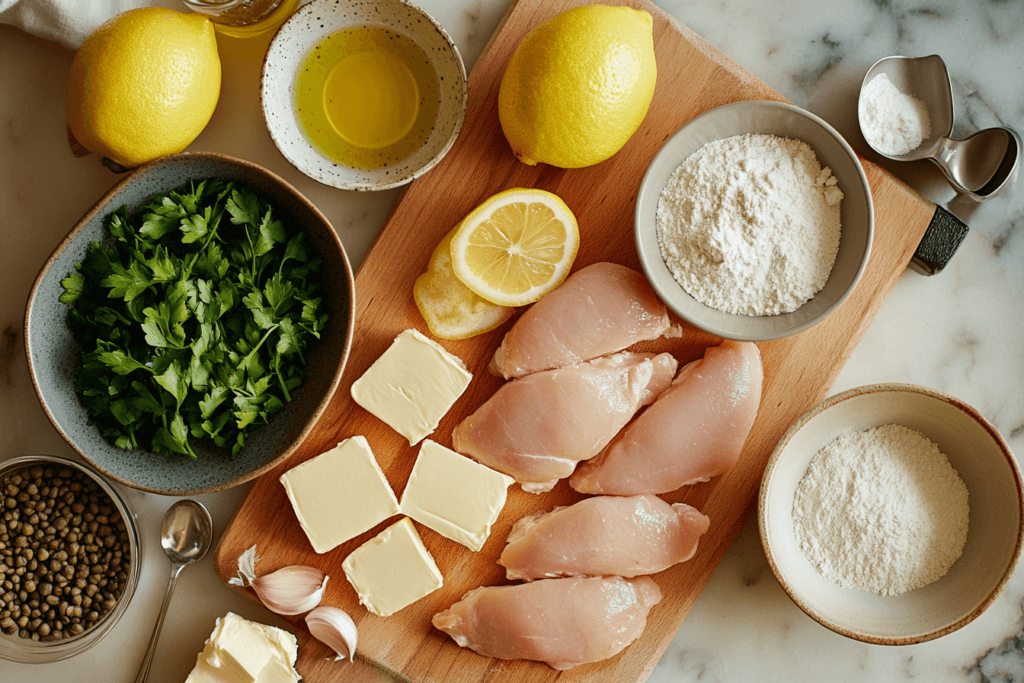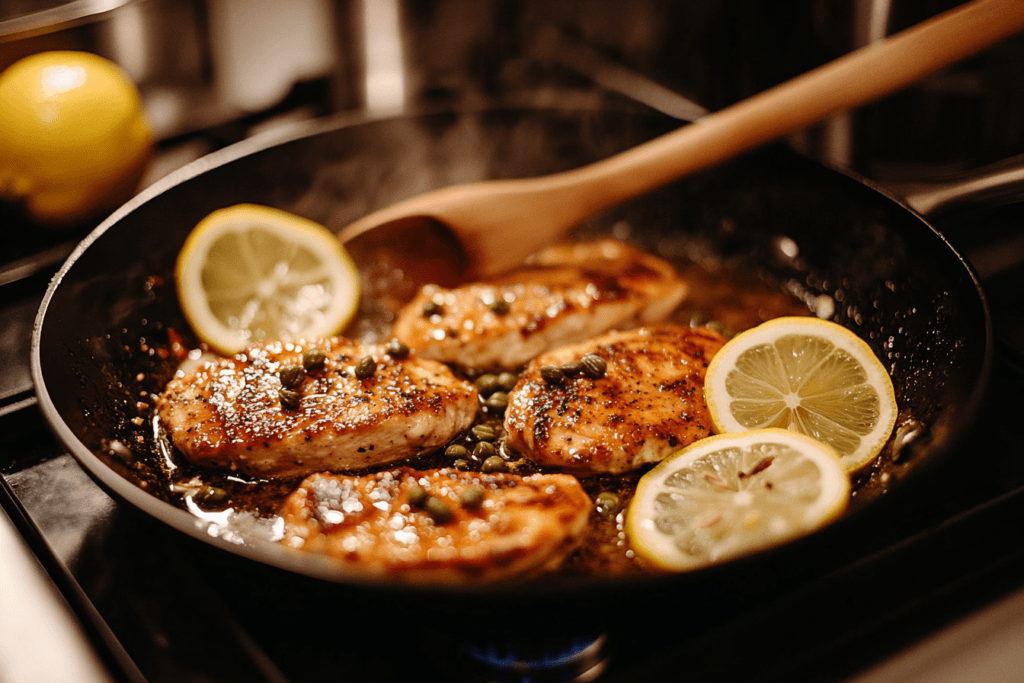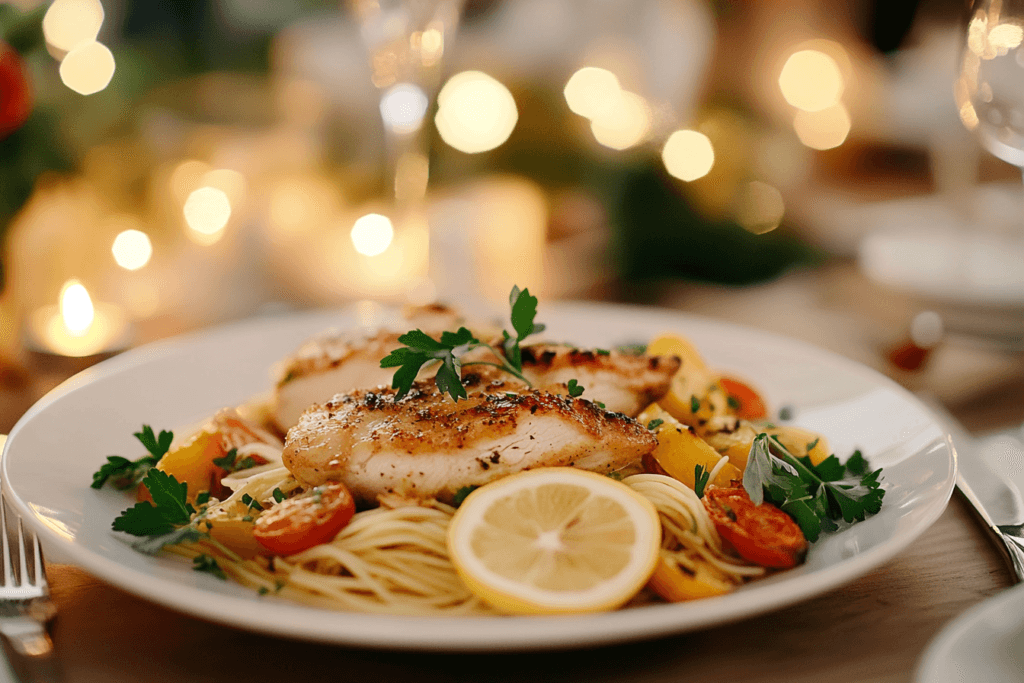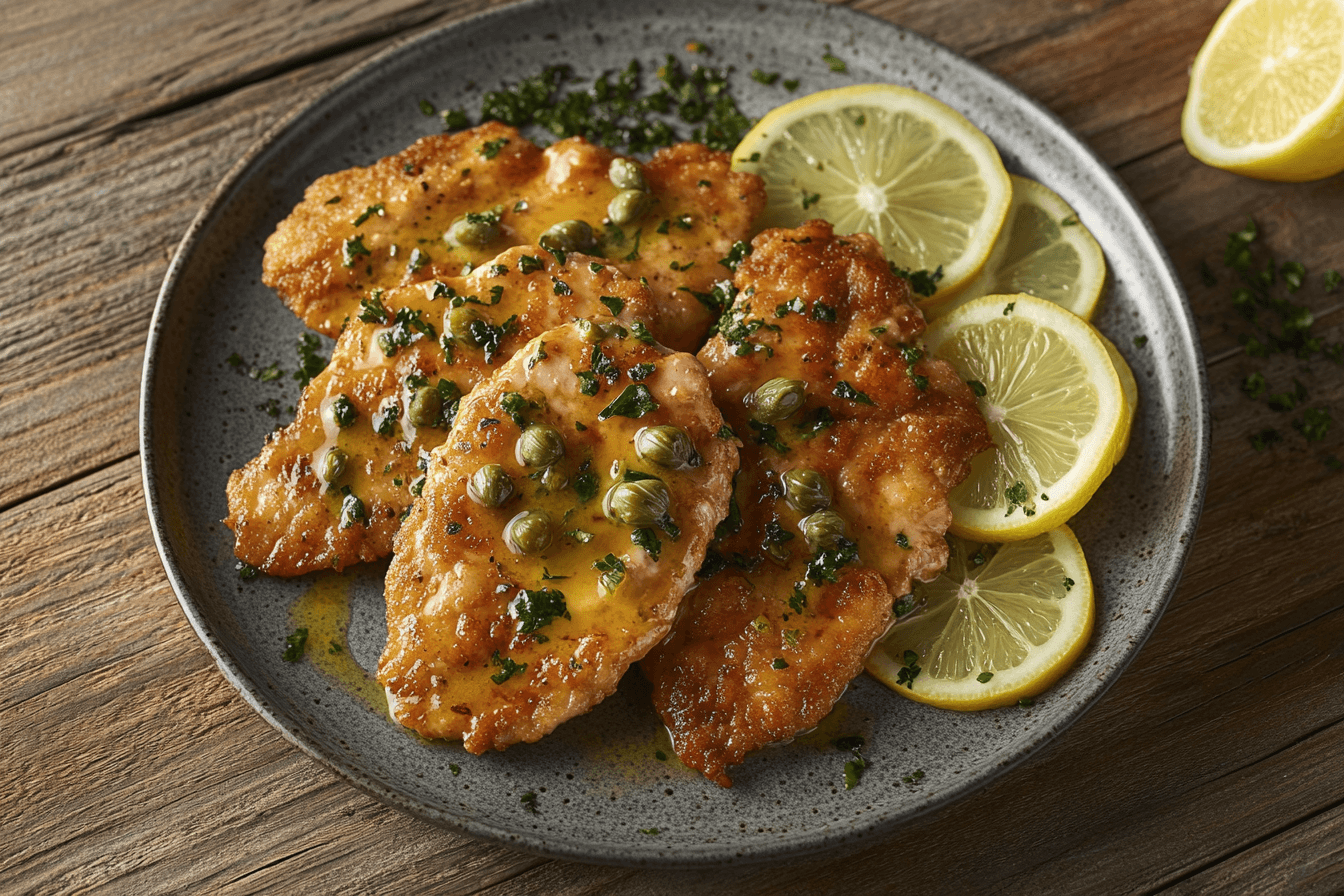Are you ready to whip up a delicious plate of chicken piccata? This classic Italian-American dish is the perfect solution for your weeknight dinner dilemmas, combining bold, zesty flavors with easy preparation. Chicken piccata is known for its tangy lemon-butter sauce, tender pan-fried chicken cutlets, and the briny burst of capers—all coming together to create a meal that feels gourmet but couldn’t be simpler to make. First, it’s quick—perfect for busy evenings. Next, it’s surprisingly healthy, with fresh ingredients that pack big flavor without weighing you down.
What makes chicken piccata truly special is its versatility! Whether served over pasta, paired with mashed potatoes, or kept light with a side of steamed veggies, it adapts to any meal plan. Plus, it’s a crowd-pleaser that will have everyone asking for seconds. Stick around, and I’ll guide you step-by-step to mastering this flavorful dish. Let’s dive in and make your new favorite dinner!


Chicken Piccata with Lemon and Capers: A Burst of Zesty Flavors
- Total Time: 35 minutes
- Yield: 4 servings 1x
Description
This Chicken Piccata recipe is a bold, zesty classic made with lemon-butter sauce, pan-fried chicken cutlets, and briny capers. It’s quick, healthy, and bursting with flavor—perfect for weeknights or special occasions.
Ingredients
- 2 boneless, skinless chicken breasts (sliced into thin cutlets)
- Salt and freshly ground black pepper
- 1/2 cup all-purpose flour (for dredging)
- 2 tablespoons olive oil
- 2 tablespoons unsalted butter
- 2 cloves garlic (minced)
- 1 small shallot (finely chopped)
- 1/2 cup chicken broth or white wine
- 1/4 cup fresh lemon juice
- 1 tablespoon lemon zest
- 2 tablespoons capers (drained)
- 1 tablespoon heavy cream (optional)
- 2 tablespoons chopped fresh parsley
- Grated Parmesan cheese (for serving, optional)
Instructions
- Slice chicken breasts into thin cutlets and pound to 1/4-inch thickness.
- Season both sides with salt and pepper, then dredge lightly in flour, shaking off excess.
- Heat olive oil and butter in a skillet over medium heat.
- Cook chicken cutlets for 3–4 minutes per side until golden brown. Remove and set aside.
- In the same pan, add garlic and shallots. Sauté until aromatic.
- Deglaze with chicken broth or white wine, scraping up brown bits.
- Add lemon juice, lemon zest, and capers. Simmer to reduce slightly.
- Whisk in butter and optional heavy cream for a smooth sauce.
- Return chicken to skillet and spoon sauce over to warm through.
- Garnish with parsley and serve hot with optional Parmesan cheese.
Notes
Serve chicken piccata over pasta, mashed potatoes, or steamed vegetables. Try variations with mushrooms, Dijon mustard, or a pinch of red pepper flakes for a spicy kick.
- Prep Time: 15 minutes
- Cook Time: 20 minutes
- Category: Main Dish
- Method: Pan-Fried
- Cuisine: Italian-American
Nutrition
- Serving Size: 1 chicken breast with sauce
- Calories: 310
- Sugar: 1g
- Sodium: 480mg
- Fat: 18g
- Saturated Fat: 7g
- Unsaturated Fat: 9g
- Trans Fat: 0g
- Carbohydrates: 10g
- Fiber: 1g
- Protein: 28g
- Cholesterol: 90mg
Keywords: chicken piccata, lemon chicken, easy dinner, weeknight recipe, capers
Key Ingredients for a Perfect Chicken Piccata
Selecting Fresh Ingredients for Chicken Piccata
When it comes to creating the perfect picatta, starting with fresh, high-quality ingredients is key. For chicken picatta, choose boneless, skinless chicken breasts or thighs. Look for chicken that is plump, moist, and has a natural pink color. If you can, opt for organic or free-range chicken, which tends to be more flavorful. Thinly slicing the chicken into cutlets or butterflying it ensures even cooking and that signature tender texture.
Fresh lemon is a non-negotiable here—it’s what gives picatta its vibrant tang. You’ll need both the juice and zest for maximum flavor. Don’t forget the capers! These little briny bursts of flavor are a hallmark of this dish. Check the label for capers packed in brine, as they are more flavorful than dry-packed ones. Lastly, make sure your pantry is stocked with high-quality olive oil and unsalted butter—these form the rich, silky base of the sauce.
Essential Seasonings and Flavor Boosters for Chicken Piccata
Chicken piccata’s simple yet bold flavor comes from the right mix of seasonings and enhancers. A sprinkle of kosher salt and freshly ground black pepper is essential for seasoning the chicken cutlets before cooking. Garlic and shallots add depth to the chicken piccata sauce, while fresh parsley serves as a bright, aromatic garnish that ties everything together.
For the sauce, chicken broth or white wine creates a rich and flavorful base. Adding freshly squeezed lemon juice enhances the tangy notes, balancing the richness of the butter. For a velvety finish, you can add a touch of heavy cream, though it’s optional. If you want to spice things up, a pinch of red pepper flakes adds a subtle kick. Finally, to elevate your chicken piccata, sprinkle some grated Parmesan cheese over the top before serving. With these essentials, your chicken piccata will have the perfect harmony of tangy, savory, and buttery goodness.

Step-by-Step Instructions for Making Chicken Piccata
Preparing the Chicken Piccata Cutlets
The first step to mastering chicken piccata is properly prepping the chicken. Start by slicing boneless chicken breasts into thin cutlets—this scaloppine-style preparation gives chicken piccata its classic texture. If the cutlets are uneven, gently pound them with a meat mallet between two sheets of plastic wrap until they are about 1/4-inch thick. This step ensures the chicken cooks evenly and stays tender.
Next, season both sides of the chicken generously with salt and pepper to bring out the flavors. Lightly dredge each piece in flour, shaking off any excess. This coating is essential for achieving the golden crust that makes chicken piccata so irresistible. Preheat a skillet over medium heat, then add a mix of olive oil and butter. The olive oil prevents the butter from burning, while the butter adds richness to the dish. Once the butter melts and starts foaming, you’re all set to begin cooking!
Cooking the Chicken Piccata Sauce
Cooking chicken piccata is where the magic truly happens. Start by placing the prepared chicken cutlets into a hot skillet. Be sure not to overcrowd the pan, as this ensures each piece fries evenly. Cook each cutlet for about 3–4 minutes per side, or until the chicken is golden brown and fully cooked through. Once done, remove the chicken from the pan and set it aside on a plate to rest.
Next, it’s time to make the signature chicken piccata sauce. Using the same skillet, build on the flavorful brown bits left behind from frying. Add minced garlic and finely chopped shallots, sautéing them until aromatic. Deglaze the pan with chicken broth or white wine, scraping up the browned bits for extra depth of flavor. Stir in freshly squeezed lemon juice, capers, and a bit of lemon zest. Allow the sauce to reduce slightly, then whisk in butter to create a smooth, glossy finish. For a creamy twist, add a splash of heavy cream and let it simmer briefly. Finally, return the chicken to the skillet, spoon the tangy sauce over the top, and let it warm through. Your delicious chicken piccata is now ready to serve!
Mastering the Caramelization Process for Picatta
Selecting Fresh Picatta
Fresh ingredients are crucial when aiming for perfectly caramelized picatta. High-quality chicken that is moist and evenly cut ensures it browns evenly in the pan. Fresh lemons, capers, and garlic also contribute to a vibrant sauce that pairs beautifully with the caramelized crust on the chicken.
Tips for Perfect Caramelization
Caramelization is all about technique. First, ensure the skillet is properly heated before adding the chicken. A hot pan helps create a golden crust without sticking. Use a mix of butter and olive oil for frying—this prevents the butter from burning while still giving the chicken that rich, buttery flavor. Avoid overcrowding the pan, as this traps steam and prevents browning.
Another pro tip? Don’t rush the process! Resist the urge to move the chicken around too soon. Let it cook undisturbed for a few minutes on each side until a deep golden crust forms. Finally, deglaze the pan with chicken broth or wine to incorporate all those caramelized bits into the sauce. This step enhances the depth of flavor and ensures nothing goes to waste.
How to Serve and Present Picatta
Garnishing and Plating Tips Picatta
Serving picatta is all about making it look as appetizing as it tastes. Start by spooning the rich, tangy sauce generously over the chicken—don’t skimp on those golden, buttery juices. Arrange the chicken neatly on a plate or a serving platter for a polished presentation.
For garnishing, freshly chopped parsley is your best friend. Sprinkle it over the top to add a pop of green that contrasts beautifully with the golden chicken and sauce. For a restaurant-quality touch, scatter a few whole capers on the plate, and zest a bit of fresh lemon over the dish right before serving. If you’re feeling fancy, a thin lemon slice on each piece of chicken adds elegance and a hint of extra zing.
Pair your dish with neutral-colored plates to let the vibrant colors shine. And remember, the first bite is with the eyes, so make it a visual treat that leaves your guests excited to dig in!
Pairing Picatta with Other Things
The beauty of picatta lies in its versatility—it pairs wonderfully with so many sides. For a hearty meal, serve it over a bed of angel hair pasta or creamy mashed potatoes, letting the sauce soak into the base for extra flavor. Prefer something lighter? Go for steamed vegetables, roasted asparagus, or a crisp arugula salad with a lemon vinaigrette.
If you’re hosting a dinner, consider pairing it with crusty garlic bread to mop up every last drop of that luscious sauce. Rice pilaf or quinoa are great gluten-free options that absorb the tangy, buttery flavors beautifully. And don’t forget a glass of chilled white wine, like Sauvignon Blanc or Pinot Grigio, which complements the lemony brightness of the dish. Whatever you choose, the pairing possibilities with picatta are endless—and always delicious.

Creative Variations of the Picatta Recipe
Spicing Up the Classic Picatta
If you’re looking to add some excitement to your chicken piccata recipe, try incorporating bold spices and unique flavors. A pinch of red pepper flakes can introduce a gentle heat that perfectly complements the tangy lemon-butter sauce. You could also experiment with smoked paprika or garlic powder in the chicken’s seasoning mix before dredging it in flour for frying.
Want to take it even further? Swap the chicken for thinly sliced turkey breast for a leaner option or tofu for a vegetarian twist on chicken piccata. If you enjoy smoky flavors, consider adding a splash of liquid smoke or using smoked salt in the sauce. For a bold citrus kick, preserved lemons can be an exciting substitute for fresh ones, offering a deeper, more concentrated flavor. However you choose to customize it, chicken piccata’s simple, adaptable base makes it the ideal dish for trying out creative twists while still delivering its signature tangy and savory goodness.
Adding Unique Ingredients to Enhance Flavor
For a unique twist on traditional picatta, consider adding unexpected ingredients. Mushrooms sautéed with garlic can bring an earthy depth to the dish. If you’re a fan of briny flavors, toss in some chopped olives alongside the capers for a Mediterranean-inspired variation.
To make the dish even more luxurious, stir in a tablespoon of Dijon mustard to the sauce for a tangy, creamy element. Love cheese? Finish the dish with a sprinkle of grated Parmesan or Pecorino Romano. For a seasonal twist, incorporate fresh herbs like thyme or rosemary into the sauce for added aroma and complexity. With a few tweaks, you can transform classic picatta into a signature dish that’s uniquely yours.
FAQs
What does piccata in Italian mean?
In Italian, “piccata” refers to a dish where meat, typically veal or chicken, is sliced thin, sautéed, and served in a tangy sauce with lemon, butter, and capers. The word “piccata” itself means “larded” or “topped with sauce,” highlighting the rich, flavorful preparation.
Is it piccata or picatta?
The correct spelling is “piccata,” with one “t.” However, some people mistakenly spell it as “picatta.” Both refer to the same dish, but “piccata” is the proper Italian term.
What’s the difference between marsala and piccata?
Marsala and piccata are both classic Italian-American dishes, but they differ in sauces and flavors. Piccata uses a lemon-butter sauce with capers, while marsala features a rich, savory sauce made with Marsala wine and mushrooms. Both are delicious but offer distinct taste profiles.
What does piccata sauce taste like?
Piccata sauce is zesty and tangy, with bright lemon flavors balanced by the richness of butter. The capers add a salty, briny kick, creating a bold and flavorful sauce that pairs perfectly with the chicken.
Conclusion
Congratulations! You’ve just learned how to make a mouthwatering plate of picatta that’s bursting with tangy lemon and caper goodness. It’s a dish that feels fancy but is so simple to prepare. With just a handful of fresh ingredients and a few easy steps, you can whip up a meal that’s perfect for both weeknight dinners and special occasions.
First, the golden pan-fried chicken sets the stage with its crispy, flavorful coating. Then, the luscious lemon-butter sauce takes everything to the next level. Don’t forget those capers—they’re the little pops of briny magic that tie the flavors together.
Whether you pair it with pasta, potatoes, or veggies, this recipe is sure to impress. So, why wait? Get your ingredients ready and bring a taste of Italian-American cuisine to your table. It’s a burst of flavor in every bite, and you’re going to love it!

